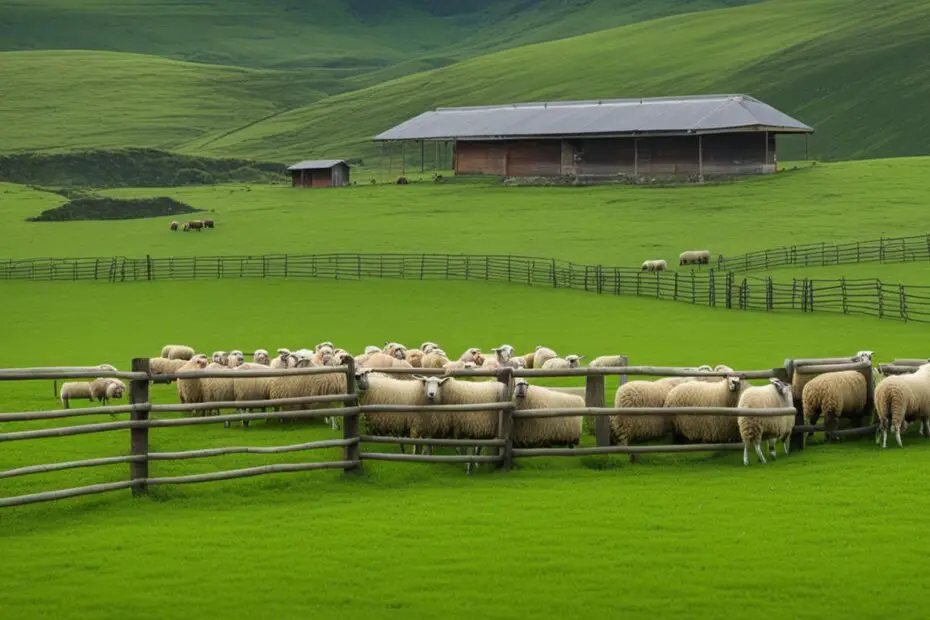Sheep need both indoor and outdoor space for optimal growth and health. Indoor space should provide enough room for normal activity and healthy social dynamics, proper traction and ventilation, and protection from the elements. The general recommendations for indoor space per sheep range from 20-25 square feet. Outdoor space should allow for grazing, socializing, and roaming, and the amount of space needed will depend on factors such as age, breed, sex, health issues, activity level, group dynamics, and climate.
Key Takeaways:
- Sheep require both indoor and outdoor space for optimal health and growth.
- The general recommendation for indoor space per sheep is 20-25 square feet.
- The amount of outdoor space needed depends on various factors such as age, breed, and climate.
- Indoor spaces should provide proper traction, ventilation, and protection from the elements.
- Outdoor spaces should allow for grazing, socializing, and roaming.
Factors to Consider for Indoor Living Spaces
When planning indoor living spaces for sheep, it’s important to consider several factors to ensure their comfort and well-being. The size of the indoor space, proper ventilation, and protection from the elements are essential aspects to take into account.
Firstly, sheep should have enough space for normal activity and healthy social dynamics. A general recommendation is to provide 20-25 square feet per sheep indoors. This allows them to move freely and interact with their flockmates.
Secondly, proper ventilation is crucial to maintain a safe temperature and prevent respiratory problems. The indoor space should be well-ventilated to allow for fresh air circulation, keeping the sheep healthy and comfortable.
Lastly, the walls of the structure should be durable and protect against drafts, precipitation, and extreme temperatures. This ensures that the indoor space provides a secure and sheltered environment for the sheep.
By considering these factors when designing indoor living spaces for sheep, you can create a safe and comfortable environment that promotes their overall well-being.
Recommended Space Guidelines for Sheep
When determining the appropriate space for sheep, it is important to consider various factors such as behaviors, activities, age, breed, sex, health issues, and group dynamics. While some established sanctuaries suggest a range of 20-25 square feet per sheep as the minimum indoor space requirement, it is crucial to tailor the space to individual needs. The Global Federation of Animal Sanctuaries emphasizes that space guidelines should focus on accommodating behaviors and activities rather than specific dimensions.
To ensure the well-being of sheep, it is recommended to provide enough indoor space to support normal activity and healthy social dynamics. This space should allow for movements such as walking, running, and playing. Additionally, it should consider the comfort and safety of the sheep by providing suitable traction and protection from drafts, precipitation, and extreme temperatures.
The amount of space needed for outdoor areas will depend on factors such as the size of the group, age, breed, health issues, and climate. Outdoor space should allow for grazing, socializing, and roaming. Providing an appropriate amount of outdoor space contributes to the overall well-being and happiness of the sheep.
| Factors to Consider for Recommended Space: | Indoor Space | Outdoor Space |
|---|---|---|
| Minimum Space Requirement: | 20-25 square feet per sheep | Varies based on factors such as group size, age, breed, health issues, and climate |
| Considerations: | – Normal activity and healthy social dynamics | – Grazing, socializing, and roaming |
| Specific Recommendations: | – Suitable traction and protection from elements | – Size should accommodate the needs of the group |
By following recommended space guidelines that focus on the individual needs and behaviors of sheep, you can ensure their overall well-being and create a conducive environment for their growth and development.
Considerations for Indoor Materials and Design
When designing the indoor space for sheep shelter, it is crucial to carefully consider the materials used in order to provide a safe and comfortable environment. The choice of materials should prioritize durability, temperature regulation, and overall safety for the sheep.
Wood, metal, and concrete block are commonly used materials for sheep shelter construction. Each material has its own advantages and considerations.
| Wood | Metal | Concrete Block | |
|---|---|---|---|
| Advantages | • Provides better temperature regulation • Durable and long-lasting • Natural and aesthetically pleasing |
• Can be more cost-effective • Easier to sanitize and clean • Resistant to pests |
• Fire-resistant • Offers additional protection against extreme weather • Provides better sound insulation |
| Considerations | • Requires ongoing maintenance • May be susceptible to pests and rot if not properly treated |
• Less effective in temperature regulation • Potential sharp edges when damaged |
• May not breathe well, leading to excessive humidity • Less visually appealing |
Overall, wood is often the preferred material for indoor sheep shelters due to its ability to regulate temperature, provide durability, and create a natural and comfortable environment for the sheep. It is important to choose high-quality wood and ensure regular maintenance to extend its lifespan.
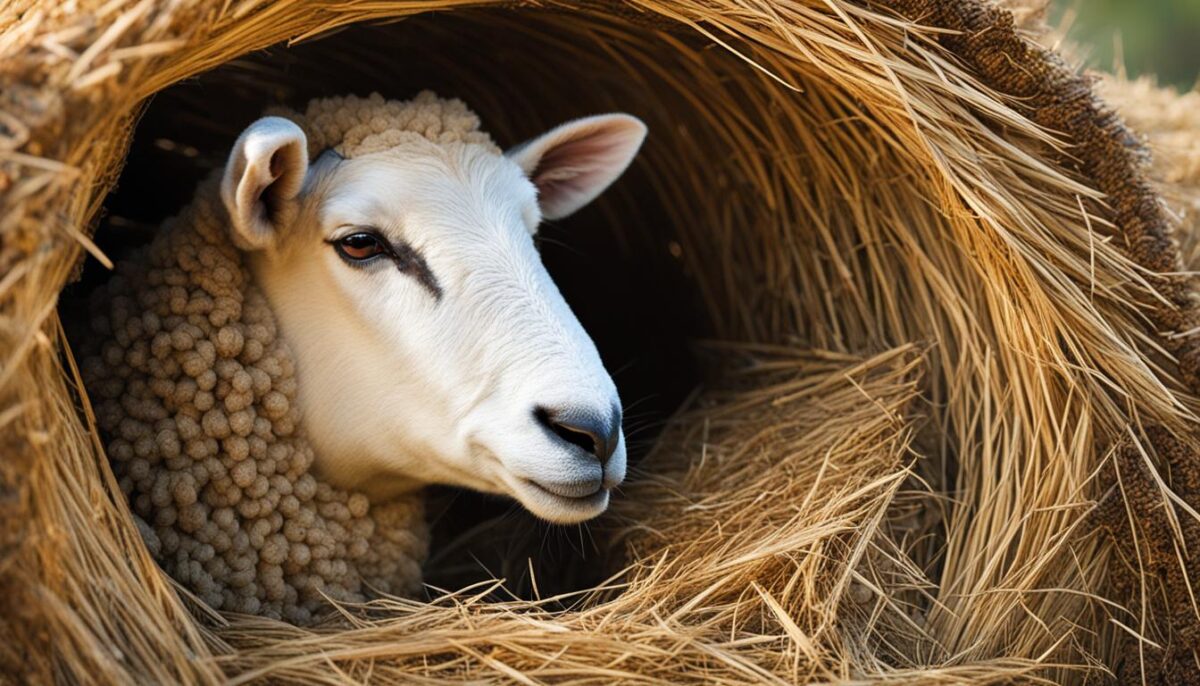
Choosing the right material for indoor sheep shelters is essential to provide a safe and comfortable environment for the sheep. Wood, metal, and concrete block each have their own advantages and considerations. Wood is often the preferred choice due to its ability to regulate temperature and provide durability. However, it is important to consider factors such as ongoing maintenance and susceptibility to pests when selecting the material for sheep shelter construction.
Designing Doors and Gates for Sheep Housing
Properly designed doors and gates are crucial for the functionality and security of sheep housing. It is important to choose the right type of doors and gates that can withstand the activity of resident sheep and provide adequate protection. Slider doors are commonly used for larger entrances, and they should be equipped with latches for full closure, partial opening, or complete opening. To prevent damage from rubbing or slamming, it may be necessary to install a heavy-duty gate on the inside of fully closed sliders. For smaller entrances, wood doors that latch shut can be used, and dutch doors offer more control over airflow. Gates should be heavy-duty and secured with latches and chains for added protection.
“Properly designed doors and gates are crucial for the functionality and security of sheep housing.”
When designing doors and gates for sheep housing, it is important to consider the size and activity level of the sheep. The materials used should be sturdy and durable to withstand daily use and potential impacts. It is also essential to ensure that doors and gates can be securely closed to prevent escape or intrusion by predators. Regular inspection and maintenance of doors and gates are necessary to identify and address any issues promptly. By designing doors and gates with the specific needs of sheep in mind, you can create a safe and secure environment for your flock.
Table: Types of Doors and Gates for Sheep Housing
| Type | Description | Advantages | Disadvantages |
|---|---|---|---|
| Slider Doors | Horizontal doors that slide open and closed | Easy to operate, suitable for larger entrances | May require additional gate for full closure |
| Wood Doors | Solid doors made of wood that latch shut | Secure closure, suitable for smaller entrances | May limit airflow and visibility |
| Dutch Doors | Doors divided horizontally, allowing for partial opening | Improved airflow and visibility | More complex design and installation |
The table above provides an overview of different types of doors and gates that can be used in sheep housing. Each option has its advantages and disadvantages, and the choice should be based on the specific requirements of your flock. It is important to prioritize safety and security while ensuring ease of use for daily operations. Choosing the right doors and gates will contribute to the overall functionality and efficiency of your sheep housing system.
Flooring Options for Sheep Housing
When it comes to choosing the right flooring for sheep housing, there are several options to consider. The flooring should provide appropriate traction, comfort, and ease of maintenance for the sheep. While concrete floors are commonly used due to their durability and easy cleaning, they may be hard on the sheep’s joints, especially if they are spending a significant amount of time indoors. To mitigate this, textured stall mats can be added for cushioning and improved traction.
Another option for sheep housing flooring is wood. Wood floors offer better traction than concrete and can provide more comfort for the sheep. However, it’s important to note that wood floors require regular maintenance to prevent damage from moisture and provide longevity. Additionally, wood floors may not be suitable for areas that are consistently wet or prone to flooding.
“Sheep housing flooring should provide appropriate traction, comfort, and ease of maintenance.”
Alternatively, some farmers opt for dirt floors in sheep housing, especially in areas where the climate allows. Dirt floors offer better cushioning than concrete and better traction than wood. However, proper drainage is crucial to prevent water accumulation and maintain a dry and healthy environment for the sheep.
| Types of Flooring | Advantages | Disadvantages |
|---|---|---|
| Concrete | Durable, easy to clean | Hard on sheep’s joints |
| Wood | Provides comfort and traction | Requires regular maintenance |
| Dirt | Better cushioning and traction | Requires proper drainage |
In summary, choosing the right flooring for sheep housing is crucial for the well-being and comfort of the sheep. While concrete, wood, and dirt all have their advantages and disadvantages, it’s important to consider factors such as climate, maintenance requirements, and the specific needs of the sheep when making a decision.
Importance of Bedding in Sheep Housing
Providing appropriate bedding in sheep housing is crucial for the comfort and well-being of the animals. Bedding serves multiple purposes, including insulation, cushioning, and ease of cleaning. It helps to create a clean and sanitary environment while promoting the overall health of the sheep.
When considering bedding options for sheep, two commonly used materials are straw and wood shavings. Straw is a traditional choice that provides good insulation and comfort for the animals. It is readily available and can be cost-effective, depending on the region. On the other hand, wood shavings offer excellent absorbency, making them ideal for managing moisture in the bedding area. They are also easy to clean and provide a comfortable resting surface for the sheep. However, it’s important to ensure that the wood shavings are free from any harmful chemicals or toxins.
Choosing between straw and wood shavings will depend on factors such as availability, cost, and personal preference. Some sheep owners may even prefer a combination of both materials to provide a comfortable and hygienic bedding environment for their animals. Regular cleaning and replacement of bedding is essential to maintain a healthy living space for the sheep and prevent the accumulation of waste and parasites.
Benefits of Straw Bedding for Sheep:
- Good insulation
- Comfortable resting surface
- Readily available
- Cost-effective in certain regions
Benefits of Wood Shavings Bedding for Sheep:
- Excellent absorbency
- Easy to clean
- Comfortable resting surface
Overall, selecting the right bedding material for sheep housing is crucial for their comfort, health, and overall well-being. It’s important to regularly assess the bedding condition, cleanliness, and odor to ensure that the animals are provided with a suitable and hygienic environment.
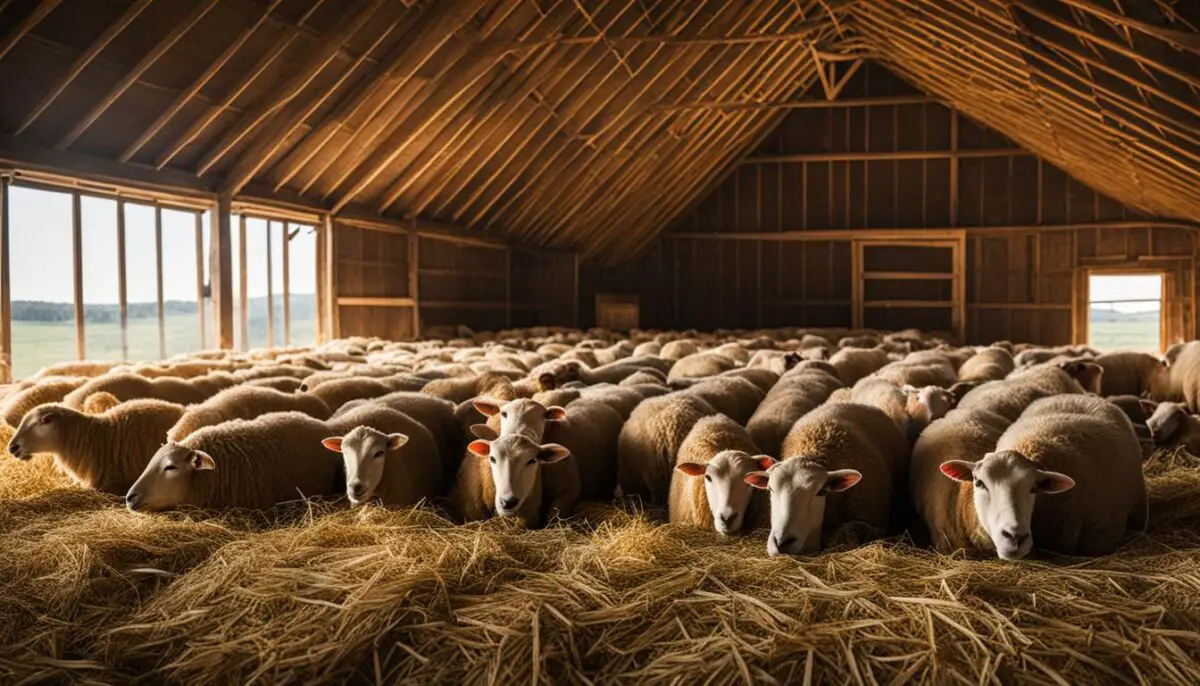
Outdoor Space and Shelter Considerations
Outdoor space is essential for sheep to thrive and lead a healthy, fulfilling life. It provides them with opportunities for grazing, roaming, and socializing. The amount of outdoor space needed will depend on factors such as the size of the flock, the quality of pasture, and the availability of alternative exercise areas. To ensure optimal conditions for your sheep, it is recommended to provide at least one acre of land per 8-10 sheep for grazing purposes.
In addition to outdoor space, providing suitable outdoor shelters is crucial to protect sheep from the elements. Run-in sheds, shade structures, or natural elements such as trees or windbreaks can serve as effective shelters. These structures should be strategically placed to provide protection from heat, inclement weather, and excessive sun exposure. Consider the climate of your region and provide adequate protection accordingly.
When designing outdoor spaces and shelters for sheep, it is important to prioritize their safety and comfort. Ensure that the shelters are well-maintained, secure, and free from any hazards such as sharp edges or protruding objects. Regular inspections and maintenance are necessary to keep the shelters in good condition and ensure the well-being of your sheep.
Grazing Area Recommendations
| Grazing Area | Number of Sheep |
|---|---|
| 1 acre | 8-10 sheep |
| 2 acres | 16-20 sheep |
| 3 acres | 24-30 sheep |
Table: Recommended grazing area per number of sheep
By providing ample outdoor space and suitable shelters, you can create an environment where your sheep can thrive and enjoy a high quality of life. Remember to consider the specific needs and requirements of your flock when determining the optimal outdoor space and shelter setup.
Fencing Requirements for Sheep
Proper fencing is crucial for keeping sheep within the designated area and protecting them from potential predators. Two commonly used types of fencing for sheep are woven wire fencing and electric fencing. Woven wire fencing is highly effective in containing sheep and keeping predators out. It consists of tightly woven wires that create a secure barrier. To prevent predators from digging underneath, it’s recommended to bury the fencing at least 1 foot below ground level.
Electric fencing is another option that can be used in conjunction with woven wire fencing. It serves as an additional deterrent to keep predators away and ensure the sheep stay within the desired boundaries. Electric fencing consists of wires that deliver a harmless electric shock upon contact, effectively deterring both predators and curious sheep.
To maintain the effectiveness of the fencing, regular inspections and maintenance are necessary. This includes checking for any damaged or broken wires, ensuring that the electrical charge is functioning properly in electric fencing, and repairing or replacing any weak spots in woven wire fencing. By implementing proper fencing measures, sheep owners can create a secure and safe environment for their flock.
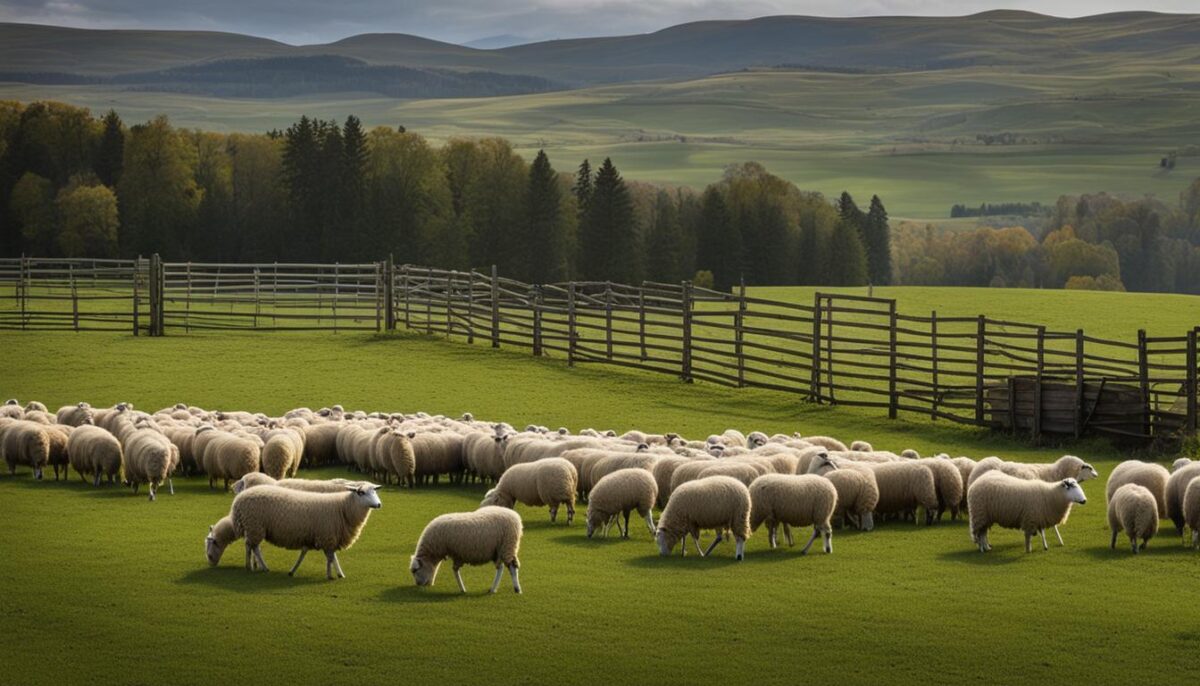
Fencing Types for Sheep
| Fencing Type | Advantages | Disadvantages |
|---|---|---|
| Woven Wire Fencing | Highly effective in containing sheep and keeping predators out | More expensive compared to other fencing options |
| Electric Fencing | Serves as an additional deterrent for predators | Requires regular maintenance to ensure the electrical charge is functioning properly |
Site Location and Ventilation Considerations
When it comes to housing sheep, site location and ventilation are two crucial factors to consider. The location of the sheep facility should be on an elevated, well-drained site that provides easy access for deliveries and manure handling. This ensures a clean and hygienic environment for the sheep. Additionally, good ventilation is essential to prevent respiratory problems such as pneumonia and bronchitis.
Proper ventilation in the sheep barn is important for maintaining air quality and regulating temperature and humidity levels. Barns should not be completely closed up or heated, as this can lead to poor air circulation and increased risk of respiratory issues. Natural ventilation, which involves the use of openings, vents, or windows, is preferable. It allows fresh air to flow in while removing stale air and moisture.
To ensure adequate ventilation, it is recommended to sit at the same level as the sheep and assess the air quality. This will help determine if there are any areas of poor airflow or excessive humidity that need to be addressed. By paying careful attention to site location and ventilation, you can create a comfortable and healthy environment for your sheep.
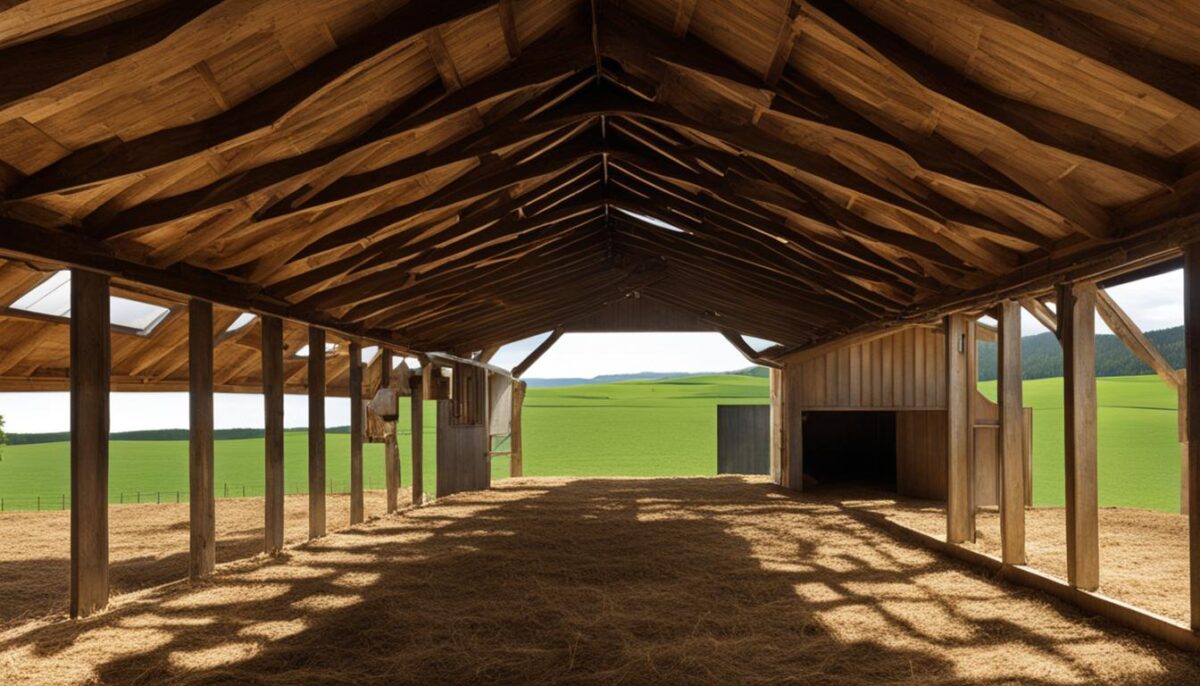
Table: Ventilation Recommendations for Sheep Barns
| Ventilation Aspect | Recommendation |
|---|---|
| Natural Ventilation | Ensure proper placement of openings, vents, and windows to allow for air exchange and prevent moisture buildup. |
| Airflow Control | Use curtains, baffles, or adjustable vents to regulate the flow of fresh air and maintain a comfortable temperature. |
| Avoid Drafts | Avoid direct drafts on the sheep, as they can lead to cold stress and respiratory problems. Optimize airflow without causing discomfort. |
| Humidity Control | Ensure proper insulation and ventilation to prevent excessive humidity in the barn, as it can lead to respiratory issues and mold growth. |
| Regular Maintenance | Inspect the ventilation system regularly to ensure it is functioning properly and make any necessary repairs or adjustments. |
Bedding Choices and Shelter for Sheep on Pasture
When it comes to sheep on pasture, providing adequate bedding and shelter is crucial for their comfort and well-being. Sheep need protection from the elements, including rain and heat, as well as a place to rest and seek shade. Here are some considerations for bedding choices and shelter options for sheep on pasture:
Bedding Choices:
While traditional bedding options like straw or wood shavings may not be as practical for sheep on pasture, there are alternative options that can provide comfort and insulation. Dried corn stalks or grass clippings can be used as bedding, as they are readily available and provide a soft surface for the sheep to lie on. These materials also decompose quickly, making them easy to replenish.
Shelter Options:
Sheep on pasture should have access to shelter that offers protection from rain and excessive heat. Natural elements such as trees or windbreaks can provide shade and protection from the sun. For smaller flocks, portable structures like port-a-huts or calf hutches can be used to provide a covered area for the sheep to seek shelter during inclement weather. These structures are easy to move and can be positioned strategically to maximize shade and protection.
It’s important to note that sheep on pasture are typically more adapted to outdoor conditions and may not require as much shelter as those housed indoors. However, providing options for shade and shelter is still essential to ensure their well-being and minimize stress during extreme weather conditions.
Table: Bedding and Shelter Options for Sheep on Pasture
The table below provides an overview of different bedding and shelter options for sheep on pasture:
| Bedding Options | Shelter Options |
|---|---|
| Dried corn stalks | Trees or windbreaks |
| Grass clippings | Port-a-huts or calf hutches |
When choosing bedding and shelter options for sheep on pasture, it’s important to consider the local climate, availability of materials, and the specific needs of the flock. Regular monitoring of the condition and cleanliness of the bedding and shelter is also essential to ensure the health and comfort of the sheep.
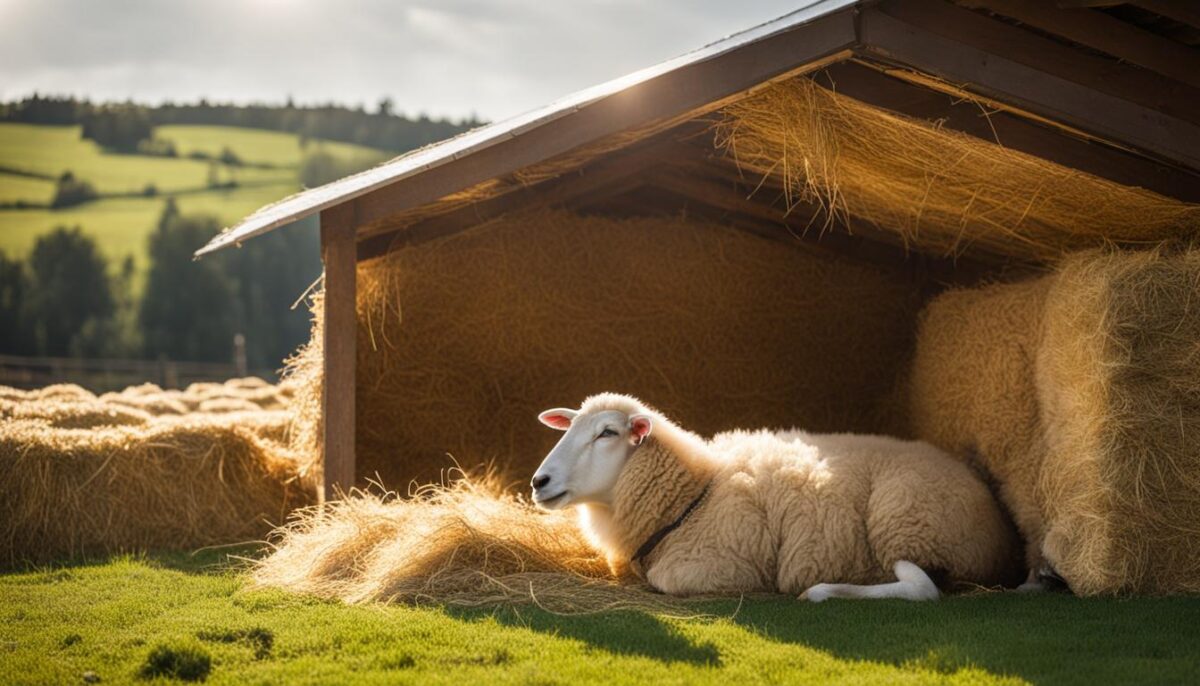
Conclusion
In conclusion, providing optimal housing for sheep is crucial for their care and well-being. By understanding their space requirements, both indoors and outdoors, we can ensure their optimal growth and health. It is important to consider factors such as age, breed, sex, health issues, and group dynamics when determining the amount of space needed for each sheep.
When designing indoor living spaces, factors such as traction, ventilation, and protection should be taken into account. Choosing the right materials, such as wood walls, and ensuring proper temperature control will provide a comfortable and safe environment for the sheep. Additionally, doors and gates should be designed to withstand activity and provide security.
Outdoor spaces should allow for grazing, socializing, and roaming. Providing adequate land per sheep and suitable shelter options will ensure their well-being in various climates. Proper fencing is also essential to keep the sheep on the property and protect them from predators.
By following these guidelines and considering the specific needs of the sheep, we can create optimal housing that promotes their health and overall care. Remember to regularly inspect and maintain the housing to ensure its effectiveness. With proper sheep care and attention to their housing needs, they can thrive and lead a fulfilling life.
FAQ
How much indoor space does a sheep need?
The general recommendation is 20-25 square feet per sheep.
What factors should be considered when planning indoor sheep living spaces?
Factors such as space requirements, traction, temperature control, protection, and safety should be considered.
Are there specific dimensions for indoor sheep housing?
The recommended space guidelines focus more on accommodating behaviors and activities rather than specific dimensions.
What materials are suitable for indoor sheep shelters?
Wood walls are generally preferred for their temperature regulation and durability, but paints or stains should be animal-friendly and safe for sheep.
How should doors and gates be designed for sheep housing?
Slider doors with latches are common for larger entrances, and wood doors can be used for smaller entrances. Gates should be heavy-duty and secured with latches and chains.
What are the recommended flooring options for sheep housing?
Concrete floors are commonly used, but textured stall mats or dirt floors can provide better traction and cushioning.
What bedding materials are suitable for sheep housing?
Common bedding materials for sheep housing include straw, wood shavings, sawdust, or even sand.
How much outdoor space does a sheep need?
It is recommended to provide one acre of land per 8-10 sheep for grazing purposes.
What type of fencing should be used for sheep?
Woven wire fencing is popular for containing sheep and keeping predators out.
What site location and ventilation considerations should be taken into account for sheep housing?
Sheep facilities should be located on elevated, well-drained sites with good ventilation to prevent respiratory problems.
What bedding choices and shelter are suitable for sheep on pasture?
Bedding options such as straw or dried corn stalks can be used, and tree coverage or simple run-in sheds can provide protection from rain and heat.


